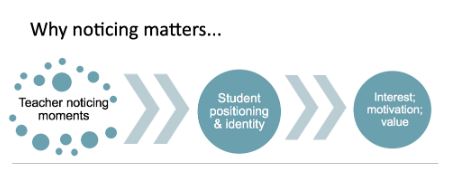Teacher Noticing: What is it and why does it matter for teaching?
by Elizabeth van Es
June 2, 2021

Enter most classrooms and you will observe a lot taking place — a teacher presenting a lesson or leading a discussion, students huddled together working collaboratively in a group, students and teachers working through and talking about the task at hand. You might also see students getting out of their seats and moving about the classroom; some students following along with the task while others are talking to their neighbors; and some students rifling through their backpacks and others simply daydreaming.
Classrooms are busy places with a lot of activity. Teachers have a lot to focus on at any given moment – they must choose what they will focus on and ignore and how to interpret what they see to move students’ learning forwards. Research on teaching defines this attentional work of teaching as teacher noticing.
Teacher noticing captures two broad dimensions: What teachers attend to and how they reason about what they observe. Let me give an example: a teacher might observe that a student has her head down on her desk and infer that the student is lazy. In this example, the teacher attended to the student and her physical position and drew an inference about what her body language means about that student and her engagement. Another teacher might also observe the student who has her head down and draw a different inference – that the student has had a challenging week and needs to take a break. Still other teachers may not even attend to the student who has her head down. Instead, their attention is focused on other aspects of what’s going on in the classroom – perhaps the ideas that students put forth, how students work together, and who has access and is invited to participate in class that day.
We can imagine then that what teachers focus on and the inferences they draw about what they observe can have serious consequences for the learning opportunities that are offered to students. If a teacher infers that a student who has her head down is lazy, then the teacher likely will not offer the student a meaningful opportunity to engage with the content. On the other hand, if the teacher infers that the student needs a break, then the teacher may follow up by offering the student the same learning opportunity as her classmates either at another time or in another format so that the student has the same chance to learn what the student missed while “taking a break.”
Why Teacher Noticing Matters
Teacher noticing has become an important idea in studying and improving teaching because it happens moment by moment, day by day, and is often invisible. Every minute teachers are attending to some things and not others and they are drawing inferences about what they observe, with some of these inferences more favorable to students than others. What this means is that how a teacher “sees” their students – how they understand students’ contributions and behaviors – has important implications for how they interact with students minute by minute, day by day. The accumulation of those interactions sends a message to students – that they are valued (or not) and that what they say and do is important and matters (or not) for their learning and for whom they can become as learners and people.
What is so powerful is that noticing happens all the time. Teachers are in constant interaction with students, so the way they manage these interactions can create a positive learning environment for students. What is challenging is that because it happens all the time, it is very hard to plan for – lesson plans can’t capture what a teacher will attend to in each moment. In addition, teacher noticing is informed by so many things – beliefs about learners and learning; the messages that the system of schooling sends to teachers and students about “what counts” and is valuable; teachers’ experiences in various communities in which they participate; “folk theories” about different groups of kids (that often dominate lunchroom conversations); and the values of the discipline and what it means to know in the discipline. All these aspects of teachers and schooling shape what they pay attention to and how they make sense of it.
Developing Noticing Practices to Advance Student Learning
Given the importance of noticing for teaching – what aspects of classroom interactions should teachers notice? The example I provided above focused on student behavior – how a student was physically positioned and what that position may reveal about the students’ level of engagement. In the US, it is not uncommon for teachers to interpret student behavior from a compliance or deficit perspective – are students doing what I want them to do? Are they showing behaviors that suggest to me that they are engaged in – or at least paying attention to – the task? Are they doing what they are supposed to do? Are they following the rules? Research in the last several decades suggests that shifting both what we attend to and how we understand it can make an important and significant difference for student learning. Efforts to improve learning opportunities for students in K12 contexts suggests that developing awareness of student thinking and patterns of student participation can lead to improvements in student learning and create a much more positive and equitable learning environment for both students and teachers.
Noticing Student Thinking
Drawing on decades of research on how people learn (Bransford, Brown, & Cocking, 1999), education and policy reform documents advocate for responsive teaching, where students’ ideas drive instructional decisions (NGA, 2010; NGSS, 2013; NCTM, 2014). Across content areas and disciplines, it is widely recognized that when learning begins by drawing on students’ existing knowledge and allowing students time to work through and make sense of new content, they have a better chance of developing deep and enduring knowledge of important concepts in the discipline. This means then that teachers’ noticing needs to shift from a focus on correct and incorrect answers early in the learning process to identifying what students know and understand relative to what is being taught, how are they making sense of what they are learning, and how the teacher can use what students understand to move learning forward. What does this look like in the content areas?
- Science – attend to students’ everyday conceptions
- Mathematics – attend to the ways learners reason about numbers and their number sense
- English/ Language Arts – attend to the ways students draw on personal experiences to make sense of text
- Social Science – attend to the ideas students have about historical events informed by their personal histories and interactions with media
But noticing is not limited to what is attended to – the inferences teachers draw about what they observe is equally important. Listening to student ideas and interpreting what they say from different perspectives opens up the learning space for students. If, for example, the interpretations come from what the discipline defines as the “right answer,” then teachers will be attending to and interpreting what students say from that viewpoint – is what I heard the student say correct or incorrect? An alternative approach is to listen to understand the reasoning behind a student idea and to then use that to move learning forward – to set-up another interaction or task that will allow the student to do more sensemaking and reasoning that will get the student closer to learning the core disciplinary idea. Now this takes a lot of on-the-fly thinking. However, what research also finds is that as teachers get better at noticing kids’ thinking they learn more about the ways students make sense of the content and can develop instructional practices for working with student ideas.
Noticing Patterns of Participation
Important research aimed at advancing equity in classrooms finds that attending to student thinking is not sufficient for providing opportunities to learn to all students. Students are part of the classroom social environment that positions students to participate in particular ways in the classroom. Classrooms have norms and routines – often unspoken – that communicate to students who is “smart” and who can be successful; who is competent; who is a leader. Classrooms are also situated inside the social, political, and institutional system of schooling that has a set of norms and practices that privilege some ways of knowing and doing over others, making teachers blind to the knowledge and practices that students from different cultural communities bring to the classroom. Teachers are not to blame for this – we are all situated inside different communities that informs what we see and how we can understand our world. However, students enter classrooms from a range of cultural communities. Learning to understand students’ cultural knowledge and practices can support teachers in providing increased access to students.
Taking Steps to Expand One’s Noticing
My aim in this essay is to draw attention to an important part of teaching that is operating minute-by-minute, day-by-day in classrooms – teacher noticing. As teachers, we are often unaware of the influence that our noticing of classroom interactions has on students – not just what they learn but also how they see themselves as learners and as people who can develop identities in the world, as writers, artists, mathematicians, scientists, and engineers. If our aim is to develop students not just as learners but also as democratic citizens, then how we attend to and interpret their thinking and participation matters for the person they become.
Fortunately, teachers can develop deeper awareness of their noticing. One way is to keep a noticing journal, where teachers reflect on important classroom interactions. Teachers can review those reflections and look for patterns in their noticing – what was I attending throughout the lesson and why was that important to me? What interpretations am I making? Is there another way to understand that interaction? To broaden teachers’ noticing, teachers can meet and discuss their reflections and share how they understand what they observed happening in their classroom. They can invite colleagues to share the ways they might interpret the same situation. When teachers come together, they often have different perspectives and can support each other in developing alternative ways to interpret events that unfold in teaching. Finally, teachers can purposely adopt different lenses – such a “strength-based perspective” – to help them interpret what they see. In this case, rather than looking for things to fix or correct, teachers can start by looking for the strengths students bring to the learning environment – such as, a strength related to understanding content or in how they interact with others – and consider how to draw on that strength to advance learning. By being on the lookout for strengths, teachers communicate to students that they have something valuable to contribute. The possibilities for student learning and success become much broader as teachers start learning from the point of view that each student has a strength and that those strengths are welcomed and celebrated in the classroom.
Further reading:
A new lens on teaching: Learning to notice Sherin, Miriam Gamoran; van Es, Elizabeth A. Mathematics Teaching in the Middle School; Reston Vol. 9, Iss. 2, (Oct 2003): 92-95.
https://www.proquest.com/docview/231077193?pq-origsite=gscholar&fromopenview=true

Elizabeth van Es is a professor at the UCI School of Education and faculty director of the UCI Teacher Academy.
